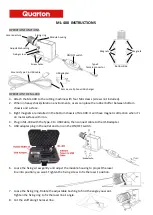
APOLLO 4000
NITRIC OXIDE DETECTION
WORLD PRECISION INSTRUMENTS
C-21
can also be purchased separately (WPI #
5436
). With proper care and by following
the instructions below a membrane sleeve should last more than one month.
Cleaning the Membrane
The membrane sleeve itself requires very little maintenance. The primary concern
is to avoid damage to the membrane and to keep it as clean as possible. After
each use the membrane should be cleaned by suspending the tip in distilled water
for 20-30 minutes to dissolve salts and remove particles, which may have
accumulated on the membrane. If the probe was used in a protein rich solution the
tip should first be soaked in a protease solution for several minutes to remove
protein build-up, and then in distilled water. Enzymatic detergent (
e.g., Enzol, WPI
#
7363
) can also be used. The membrane sleeves can also be sterilized chemically
using an appropriate disinfectant (
e.g., Cidex, WPI #
7364
). Accumulated organic
matter can be removed by briefly immersing the tip in an acid or base solution (at
times both may be necessary) for 10 seconds. A good indication of a dirty
membrane sleeve is a sluggish response or an unusually low sensitivity. If these
problems are not rectified by the above cleaning procedures then the membrane
sleeve should be replaced.
The probe cannot be used in organic
solvents.
Replacing a Membrane Sleeve
All membrane sleeves will eventually have to be replaced by the user. The
procedure for doing so is simple and straightforward.
1.
Unscrew the locking cap from the handle.
2.
Hold the stainless steel sleeve and remove it with the locking cap from the
internal electrode assembly, being careful not to bend the electrode assembly
when doing so.
3.
Rinse the internal electrode with distilled water (particularly the tip) and let it
soak for at least 15 minutes. Be careful not to let water get into the handle. The
current on the ISO-NO meter should go offscale when the electrode is being
rinsed.
4.
Gently dry the electrode with a soft tissue (Kimwipes). Be sure to dry
thoroughly the flat surface at the tip of the electrode. After drying the current
should stabilize fairly quickly to a low value (
e.g., 0 - 20 pA). If this occurs then
the electrode is in good working order.
Summary of Contents for APOLLO 4000
Page 2: ......
Page 4: ......
Page 10: ...APOLLO 4000 INTRODUCTION WORLD PRECISION INSTRUMENTS A 6...
Page 48: ...APOLLO 4000 NITRIC OXIDE DETECTION WORLD PRECISION INSTRUMENTS C 24...
Page 70: ...APOLLO 4000 TROUBLESHOOTING WORLD PRECISION INSTRUMENTS F 2...
Page 72: ......
Page 74: ......
















































